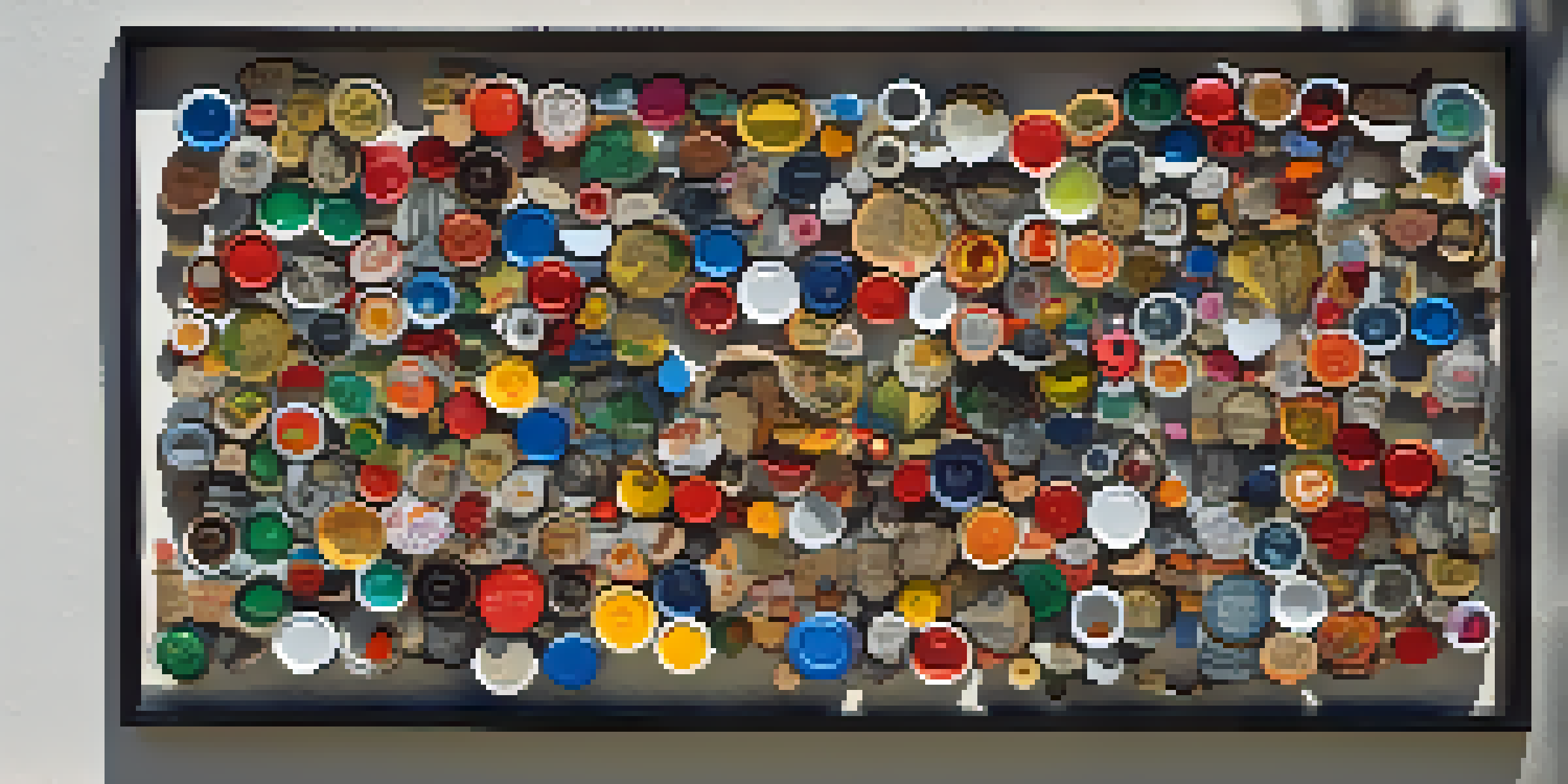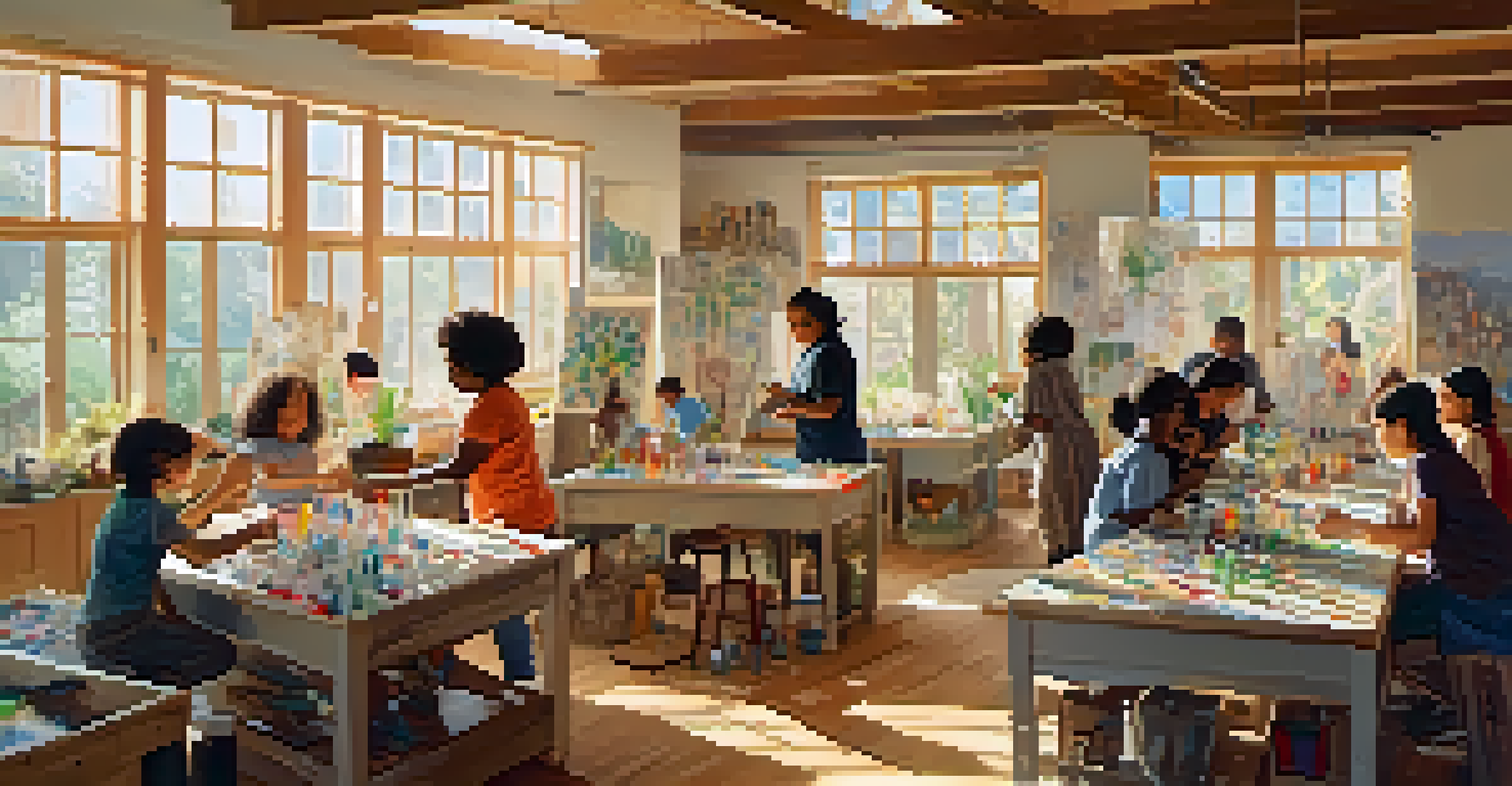The Use of Recycled Materials in Modern Art Creations

The Rise of Recycled Materials in Art
In recent years, there has been a significant shift in the art world towards using recycled materials. Artists are increasingly recognizing the potential of these materials, not only for their sustainability but also for their unique textures and stories. This trend reflects a broader societal movement towards environmental consciousness and responsible consumption.
Art is not a mirror to hold up to society, but a hammer with which to shape it.
Recycled materials bring a sense of history and narrative to art pieces, allowing artists to create works that resonate on multiple levels. For example, a sculpture made from discarded metal can evoke thoughts about industrialization and waste. By incorporating materials that have already lived a life, artists can engage viewers in a dialogue about the past and the future.
Furthermore, this practice encourages creativity and innovation. Artists are challenged to think outside the box, transforming everyday objects into something extraordinary. The result? A vibrant, diverse art scene that celebrates sustainability while pushing the boundaries of traditional artistic mediums.
Notable Artists Using Recycled Materials
Many contemporary artists have embraced recycled materials as a central part of their practice. For instance, El Anatsui, a Ghanaian artist, is renowned for his stunning wall sculptures made from bottle caps and discarded aluminum. His work not only showcases beauty but also comments on consumerism and waste, urging viewers to reconsider their relationship with everyday objects.

Another notable figure is Vik Muniz, who creates intricate images using materials like chocolate syrup, dust, and even garbage. Muniz’s art often challenges viewers to think about the value we assign to materials and the stories they tell. His work exemplifies how recycled materials can serve as both medium and message, enriching the viewer's experience.
Recycled Materials Enhance Art
Artists are increasingly using recycled materials to create art that is not only sustainable but also rich in history and narrative.
These artists and many others are redefining what art can be, showing that creativity knows no bounds when it comes to materials. By spotlighting recycled components, they inspire a new generation of artists to explore the intersection of art, sustainability, and social commentary.
The Environmental Impact of Art Materials
The art industry, like many others, has a significant environmental footprint. Traditional materials such as oil paints and canvas often involve processes that contribute to pollution and resource depletion. By contrast, using recycled materials helps mitigate these impacts, promoting a more sustainable approach to artistic creation.
The greatest threat to our planet is the belief that someone else will save it.
Moreover, the use of recycled materials can raise awareness about environmental issues. When artists incorporate items like plastic waste or old newspapers, they create a visual representation of the problems our planet faces. This not only educates the audience but also encourages them to reflect on their own consumption habits.
As the art world continues to evolve, the embrace of recycled materials serves as a powerful reminder of the role art can play in advocating for environmental stewardship. It's a clear call to action for artists and audiences alike to consider the life cycles of the materials we use.
Techniques for Working with Recycled Materials
Working with recycled materials often requires artists to adopt unique techniques that differ from traditional methods. Artists may need to experiment with various adhesives, tools, and assembly processes to bring their visions to life. This exploration can lead to unexpected discoveries and innovations in their work.
For instance, some artists combine different materials to create mixed-media pieces that challenge the viewer’s perception of art. By layering textures and forms, they can produce visually striking compositions that provoke thought and emotion. The tactile nature of recycled materials adds an additional layer of engagement, inviting viewers to interact more deeply with the artwork.
Innovative Techniques Emerge
Working with recycled materials inspires artists to adopt unique techniques, fostering creativity and unexpected artistic discoveries.
Additionally, the process of sourcing and selecting materials can itself be an artistic endeavor. Many artists enjoy the thrill of scavenging local thrift stores, flea markets, or even the streets for potential treasures. This treasure hunt not only supports the art-making process but also fosters a deeper connection between the artist and the materials they choose.
Community Engagement and Art Education
The use of recycled materials in art often extends beyond individual artists to encompass community engagement and education. Workshops that focus on creating art from recycled materials can empower participants to express themselves while also advocating for sustainability. These events not only foster creativity but also instill a sense of responsibility toward the environment.
Schools and community centers are increasingly incorporating recycled art projects into their curricula, helping to cultivate a new generation of environmentally conscious artists. By teaching students to see value in discarded materials, educators are encouraging innovative thinking and problem-solving skills. This hands-on approach makes environmental issues more relatable and actionable for young minds.
Moreover, community art projects that utilize recycled materials often bring people together, fostering collaboration and dialogue. These initiatives can beautify neighborhoods while simultaneously raising awareness about waste reduction and recycling, proving that art can be a powerful catalyst for change.
The Future of Recycled Art
As we look to the future, the role of recycled materials in art is likely to expand even further. With growing awareness of environmental issues and a push for sustainable practices, more artists may turn to these materials as a primary focus in their work. This shift could lead to innovative art movements that prioritize ecological considerations alongside artistic expression.
The integration of technology also plays a crucial role in shaping the future of recycled art. Digital platforms can help artists showcase their work to a global audience, while new tools and techniques can enhance the creative possibilities of recycled materials. For instance, 3D printing with recycled plastics opens up exciting avenues for artists to explore.
Community Engagement Through Art
Art projects that utilize recycled materials promote community involvement and education, encouraging a sense of responsibility toward the environment.
Ultimately, the future of recycled art is not just about aesthetics; it's about fostering a culture of sustainability and responsibility. As artists continue to push boundaries and challenge norms, recycled materials will serve as a powerful medium for expression, reflection, and advocacy.
How to Support Artists Using Recycled Materials
Supporting artists who work with recycled materials can take many forms, from purchasing their artworks to attending exhibitions. Many galleries now feature artists committed to sustainability, providing a platform for their work and educating the public about the importance of recycling. By engaging with these artists, you contribute to a larger conversation about environmental stewardship.
You can also participate in local art fairs or community events that promote recycled art. These gatherings often showcase talented artists while providing opportunities for hands-on workshops and activities. By getting involved, you not only support the artists directly but also help spread awareness about the value of recycling and creativity.

Finally, consider sharing your enthusiasm for recycled art on social media. Highlighting the work of artists who use recycled materials can inspire others to appreciate and support this important movement. Together, we can help amplify their voices and the essential messages they convey through their art.